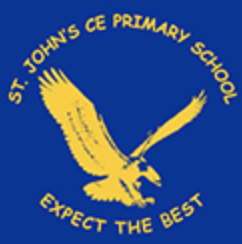
Phonics and Reading
At St John’s, quality phonics is taught using the Sounds-Write approach – a linguistic phonics programme which underpins the teaching of reading and writing from Early Years to Year 6. This embeds the early reading strategies taught in Reception and KS1 through to supporting children in their spelling strategies in KS2. Children are taught to understand the relationship between spoken language and written words, right from the start of their Sounds-Write journey. Their learning is carefully sequenced to teach them how each of the 44 or so sounds in the English language can be spelt.
In Early Years and KS1, phonics is taught explicitly on a daily basis and in KS2, phonics is taught explicitly three times a week. Phonics is taught whole-class and for those children who did not fully understand the learning receive additional support by repeating the lesson or through tailored phonics sessions by trained support staff. This ensures that children catch up and keep up with the whole-class teaching.
In Early Years, children are taught the Initial Code. It teaches them the concept of one sound, one spelling. CVC words (consonant, vowel, consonant e.g. dog, man, sit) are taught first until all single-letter sound-spelling correspondences are taught then they look at double consonant spellings (e.g. ss, ll, zz). Once the children have become confident in these spellings, they are then exposed to spellings with two different letters (e.g. ch, sh, th). As the programme progresses, children learn to read and write words with a more complex structure.
In KS1, children will apply and build upon their learning in the Early Years by learning the more spellings of the different sounds. This is called the Extended Code. They learn the concept that one sound can be represented by multiple spellings. For example, Unit 1 of the Extended Code teachers the sound /ae/ which can be spelt as <ai> in plain, <ea> in steak, <ay> in play and <a-e> in cake. They also learn the concept that one spelling can represent multiple sounds like <ou> can make the /oo/ sound as in ‘soup’, the /u/ sound in ‘trouble’ and the /ow/ sound as in ‘loud’.
In KS2, children will continue to learn the different spellings of the different sounds through focus of the Y3/Y4 and Y5/Y6 word lists and spelling objectives. The children will also begin to learn the etymology of words that supports them in their spellings and they will analyse interesting spellings of words.
Children at the end of Year 1 take part in the statutory Phonics Screening Check to assess if they can decode words using phonics. It consists of reading 40 words, a mix of real and pseudo-words, one to one with an adult. The purpose of the pseudo words is to see if a child can use their phonics knowledge to decode a word, rather than relying on their memory or vocabulary. It will also help identify those pupils who may need extra support to improve their decoding skills. Those children who do not meet the expected standard, must take the test again in Year 2.
To support the learning in school, we have included some useful documents and information about the teaching of phonics and reading at home.
Prompts for reading with your child
The Book Introduction
· Talk about what sort of book it is e.g. Fiction, non-fiction, poetry
· Where possible relate the story to the children’s own experience
· Look at front cover and
· encourage prediction; Who? Where? What?
· Look at back cover and blurb
· Look at the illustrations and talk about them together.
Sharing the book together
· Ask open questions about the text and characters - ‘why do you think…?’
· Model language patterns that may be unfamiliar.
· Point out high frequency words (‘tricky words’)
· Encourage prediction
· Occasionally dip into the text and talk about letter-sound relationships (phonics).
Prompts for Independent Reading
· Were there enough words?
· Read it with your finger this time.
· Read it again to see if you can make the words match. Were you right?
· Where is the tricky word?
· What did you notice?
· Would ……….. fit there?
· Would ………. make sense?
· Do you see a word you know?
Check the picture.
· What happened in the story?
· What would make sense in the sentence there and sound right?
· What would you expect to see at the beginning of ……..
When your child has finished
- Show me how you point as you read
- Show me what a word is.
- Show me a letter
- Find a word that starts with …..
- Put this word card under...
- Can you make this word with your letters?
- Put a counter under a capital letter / full stop on page ….
- Can you find a lower case ….to match capital…..?
- Can you find speech bubbles, speech marks?
- Can you find a word that rhymes with …..?
- Can you find a word that starts with…..?
Recall Questions
- Where does the story take place?
- When did the story take place?
- What did he/she look like?
- Who was he/she?
- Where did he/she live?
- Who are the characters in the book?
- Where in the book would you find?
Follow-on activities
- Play a game using text from the book.
- Re-order chopped up sentences or words from the book.
- Write your own story based on the book and illustrate.
- Re-tell the story with finger puppets.
- Re-read familiar texts with the same or similar structure.
- Paint a picture of a favourite character, part of the story, etc
HAVE FUN TOGETHER
Helping your child read a decodable book within the Sounds Write scheme
In this video, it shows you how to help your child to read a decodable story.
